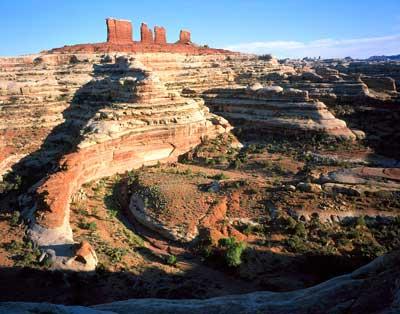A 64-year-old man from North Carolina was injured in a fall during a solo hike in a remote section of Canyonlands National Park last week. Unable to walk, he faced long odds, since no one was aware of his plans or location. What followed was a tale combining grim determination and alert work by rangers.
The saga began when Amos Richards attempted to hike in and out of Lower Blue John Canyon via the entry and exit route between West and Little Blue John Canyons. During the trip, he fell approximately 10 feet trying to gain the wash bottom, suffering extensive leg trauma in the process.
A serious injury anywhere in this vast expanse of Utah canyon and desert country is always a cause for concern, but Richards was faced with some extra challenges. The location of his mishap was near an area known as the Maze District, which is described as "the least accessible district of Canyonlands. Due to the district's remoteness and the difficulty of roads and trails, travel to the Maze requires more time, as well as a greater degree of self-sufficiency. Rarely do visitors spend less than three days in the Maze, and the area can easily absorb a week-long trip."
Richard's injuries were serious enough that he couldn't bear weight on his right leg, but he was hiking alone, and no one else was aware of his plans or his location. As a result, it was unlikely that anyone would be aware of his plight and began a search. In a remarkable tale of determination, Richards began crawling back across the rough desert terrain in an attempt to reach his vehicle.
His grueling effort would last for the next three nights and four days. The hiker reportedly had no overnight gear, warm clothes or a map, and it rained on him several times during his crawl. The only good news may have saved his life: he had taken five liters of water and two power bars with him on his hike.
This was a situation that could easily have ended sadly, but Richard's prospects began to improve when rangers in the park's Island in the Sky District noticed that a campsite in the Willow Flat campground appeared to be unoccupied and abandoned.
That campground is many a lonely mile from Richard's location in the Maze, but investigation by the rangers led them to believe the visitor may have headed for that vicinity.
A search was begun and Richards was spotted from a helicopter in the area of Little Blue John Canyon, just outside the park’s boundary. The victim was flown to Moab Regional Hospital, where he was treated for leg fractures, internal injuries, trauma, and dehydration.
A park spokesperson says Richards is expected to make a full recovery.




Comments
Solo hikers: Wear dog tags which will identify the body.
Nonsense, I've hiked, canoed, kayaked, and overnight backpacked on extended trips alone, and in 40 years of doing so never had a situation that I would consider even a close call. Being prepared, and leaving plenty of safety margin in every decision, is key. I'll bet if I could see where he fell, I would tell you I would have walked away from that descent if alone.
But saying don't hike alone is nonsense. Don't hike alone foolishly is better.
Hiking alone is not the problem. It is people who fail to plan for problems that might occur. SPOT now has the ability to send a gps signal when you have an emergency. Carrying one of these he would have had help quickly. Absent that the tried and true method of telling someone where you are going and when you will be back so they can alert authorities if you don't show up on time works too.
Hiking alone is a pleasure and we should never discourage it.
in todays day and age the technology is out there and its cheap enough that if you want to travel alone at least carry a gps or a alert beacon or something. I am happy he is alive , but he [should have been] properly prepared for a hike.
I have no problem with the man hiking alone. The problem I see, as Jim's article reports is "no one else was aware of his plans or his location, no overnight gear, warm clothes or a map". I am glad the story has a happy ending.
[This comment was edited to remove a gratuitous remark. Ed.]
During my last visit to the Bluejohn area in April 2011 I discovered they had added a cell phone tower that allowed cellular access at both the Horeshoe Canyon trailhead and the Maze Ranger Station at Hans Flat. I wonder why he was unable to contact anyone with his cell phone, or if he even took one?
Otherwise, that area is NOT a place for a single hiker! It is so easy to sit at the trailhead and ask other hikers if you can "tag along" if necessary. Horseshoe also has guided rangers in the canyon on the weekends. PLEASE be careful out there!
I made several 50 Mile solo hiking trips in the Sierra Nevada Mountains, traveling light I often times carried the bare minimum needed to survive. But I grew up in the mountains and learned what is edible and what will result in my becoming condor food. Always made sure I had a water filter, warm clothing and a mylar space blanket, my K-Bar knife, fish line, hooks .22 caliber pistol and a ham radio so I could call for help. Most important I told people what I was doing and where and how long I would be hiking.
"In a remarkable tale of determination"... The only thing remarkable is his lack of good judgment. On second thought, because people do this sort of thing so often, I guess it isn't really all that remarkable. (Ed. note: this comment has been edited slightly to remove a gratuitous remark.)